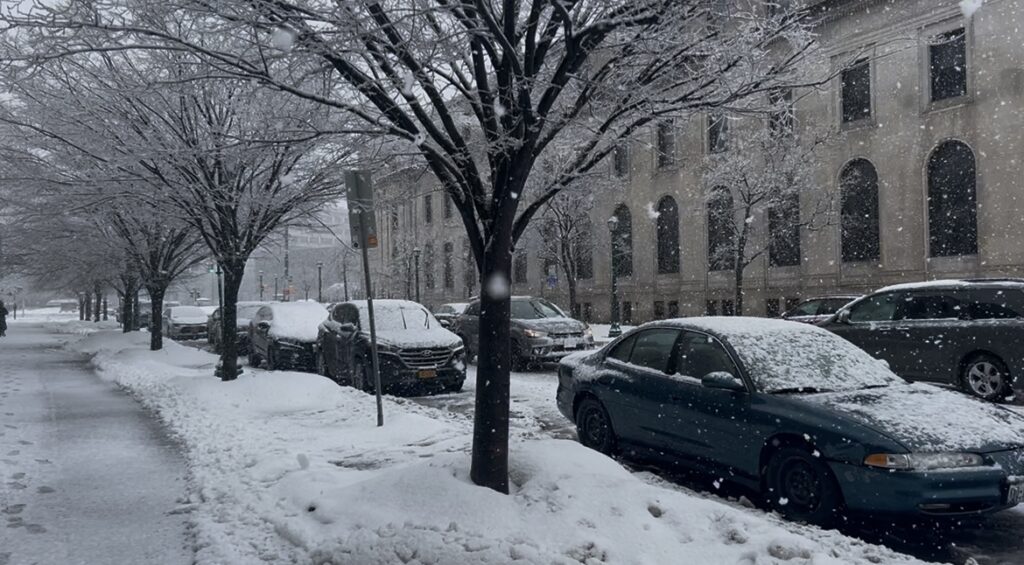
SYRACUSE, N.Y. (NCC News) — Winter weather can turn driving into a real challenge.
Snow, ice and freezing temperatures make roads slippery and harder to navigate. But with a few simple steps, you can stay safe and avoid accidents.
Jason Rockwell, the Chief Operating Officer at ABLE 2 Driving School in Syracuse, shared some tips for safer driving this winter. Here are a few things you can do to stay safe on the road.
Get Your Vehicle Ready for Winter
Before hitting the road, it’s important to make sure your car is ready for winter. Start by checking your tires. Tires with good tread are a must for traction in icy conditions.
“Don’t underestimate the value of the snow tire. You know, snow tires, as much as they’re more expensive and people don’t want to spend that extra money, that honestly could be the difference between life and death unfortunately,” said Rockwell.
Also, try to keep your gas tank at least half-full throughout the winter season. This helps prevent your fuel lines from freezing in the cold and ensures you’ll have enough fuel if you get stuck.
Change Your Driving Habits for Winter
Even if your car is in good shape, you’ll need to adjust how you drive in winter weather.
“A common mistake that drivers make when driving in winter conditions, I’d have to say, is our attitude. That’s what I see most of the time. You need to remember, this isn’t summer,” said Rockwell.
Icy and snowy roads require more time to stop, so going slower will give you more control over your vehicle.
“So the road you’re on might be 55. It’s a beautiful day outside. But when you’re driving in winter conditions, you would have to drop that down to 30 or even lower,” said Rockwell.
Another important tip is increasing your following distance. In snowy weather, it takes longer to stop, so it’s important to leave extra space between you and the car in front of you.
“So under ideal conditions, you want to keep what they call the three-second rule. So you want to be three seconds behind that car in front of you. But as the conditions worsen, let’s say you have wet roads, you double it, you go to six seconds, and then if it’s snow and ice covered, you want to triple,” said Rockwell.
What to Do if You Start Skidding
It’s crucial to make sure you’re steering gently. Sudden movements can cause you to lose control. This goes for accelerating and braking, too.
If you do start skidding on ice or snow, it’s important to stay calm.
“So if the back end [of your car] is swerving to the right, then you’re just going to simply steer to the right. If the back end is swerving to the left, then you steer to the left. It’s called steering into the skid,” said Rockwell.
He emphasized the importance of steering gently. If you steer too abruptly, it can cause the back end of your car, already swerving to the right, to suddenly shift and start swerving to the left.
“Now you have to hurry up and try to get it back to the left. It’s all about whatever direction the back end of your car is moving,” Rockwell said.
Transcription for the video package
Rosie Rapisarda: When winter hits… roads can quickly go from familiar… to dangerous…especially at night when the challenges of driving in the snow can become even more severe.
Jason Rockwell: ” You go a mile up the road and all of a sudden, you got a whiteout. You gotta see that you gotta plan ahead and just tell yourself, okay, I’ll get through this. But the main thing is going to be making myself more visible, slowing down and increasing my following distance.”
Rapisarda: Winter driving can be tricky, but the good news is, that a lot of accidents can be avoided with some simple safety steps.
Rapisarda: Simple actions like checking your tires, making sure your windshield wipers are in
good condition, and keeping your gas tank at least half-full can make a big difference. Being proactive and adjusting your driving habits to the conditions such as slowing down, increasing your following distance, and steering gently can help keep you safe on the road.
Rapisarda: But the most important tip of all … is knowing how to react when skidding.
Rockwell:“So if the back end is kicking to the right, then you’re just going to simply steer to the right. It’s called steering into the skid. You shouldn’t have to do that super far. If you do go a little bit too far, then you’re gonna have to fight it and you’re gonna have to go back to the left cause now the back end is gonna kick to the left. Then you’re just gonna want to turn it to the left a little bit.”
Rapisarda: Stay safe on the roads, and remember: it’s not just about reaching your destination, but getting there safely. Rosie Rapisarda, N-C-C News.
